Advance Concepts of Modeling in AI class 10 notes – The CBSE has changed the syllabus of Std. X. The notes are made based on the new syllabus and based on the New CBSE textbook. All the important Information are taken from the Artificial Intelligence Class X Textbook Based on CBSE Board Pattern.
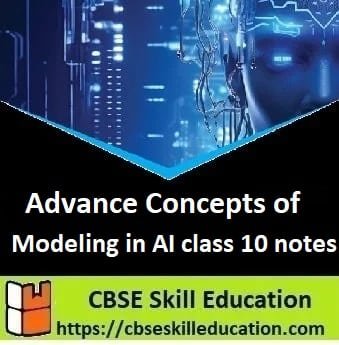
Advance Concepts of Modeling in AI class 10 notes
Differentiate between AI, ML, and DL
Artificial intelligence (AI) is the ability of machines to do cognitive tasks such as thinking, perceiving, learning, problem-solving, and decision-making. ML and DL is a subset of Artificial Intelligence.
Venn Diagram of AI
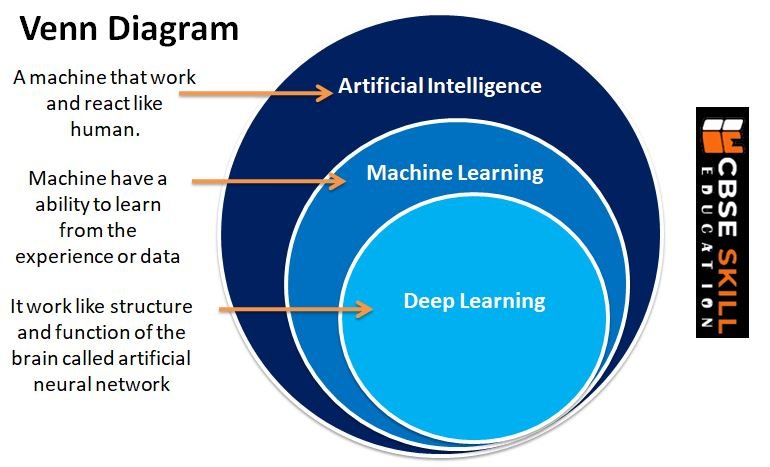
| Artificial Intelligence | Machine Learning | Deep Learning |
|---|---|---|
| AI can simulate human intelligence to perform the task. | ML is a subset of AI, which uses algorithms to learn patterns from data. | DL is a subsite of ML that uses artificial neural networks for complex tasks. |
| AI has predefined rules. | ML depends on labeled data for making predictions | DL requires large labeled data to perform tasks |
| AL can be rule-based and require human programming | ML can learn automatically with less human intervention | DL automates feature extraction and lessens human intervention |
| AI is used in virtual assistants, recommendation systems, etc. | ML is used in spam filtering, image recognition, etc. | DL is used in speech recognition, autonomous vehicles, etc. |
Artificial Intelligence
Artificial intelligence (AI) is the simulation of human intelligence in robots that have been trained to think and act like humans. The term can also refer to any machine that demonstrates, like humans, the ability to learn and solve the problem is Artificial Intelligence.
Machine Learning (ML)
Machine learning is a part of an Artificial Intelligence application in which we give data to the machine and allow them to learn for themselves. It’s essentially getting a machine to accomplish something without being specifically programmed to do so. The machine learns from its mistakes and takes them into consideration in the next execution. It improvises itself using its own experiences.
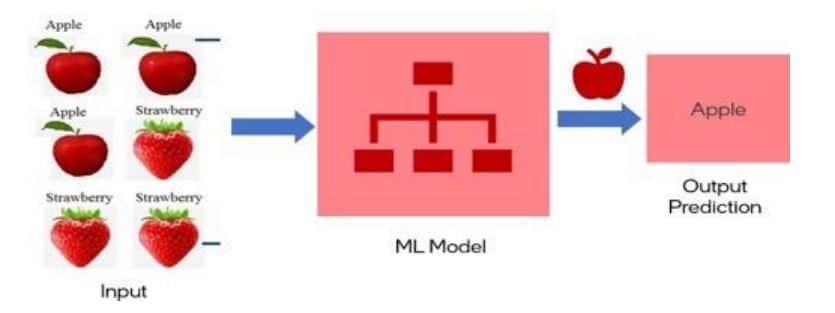
Here is an example which shows labelled images (every image is tagged either as apple or strawberry) are given as input to the ML model. ML model learns from the input data to classify between apples and strawberries and predicts the correct output as shown.
Examples of Machine Learning (ML)
- Object Classification – Object classification refers to the process of identifying and categorizing specific objects within an image or video. For example, there is an image with multiple animals; if you want to categorize or identify a specific animal, then it is only possible with machine learning.
- Anomaly Detection – Anomaly detection helps us find the unexpected things hiding in our data. For example, tracking your heart rate, and finding a sudden spike could be an anomaly, flagging a potential issue.
Deep Learning (DL)
Deep learning is a part of Artificial Intelligence that uses neural networks with multilayer. Deep learning analyzes the data, learns the data and solves the problem the same as a human. Deep learning requires the machine to be educated with a large quantity of data in order to train itself. Deep Learning is the most advanced form of Artificial Intelligence out of these three.
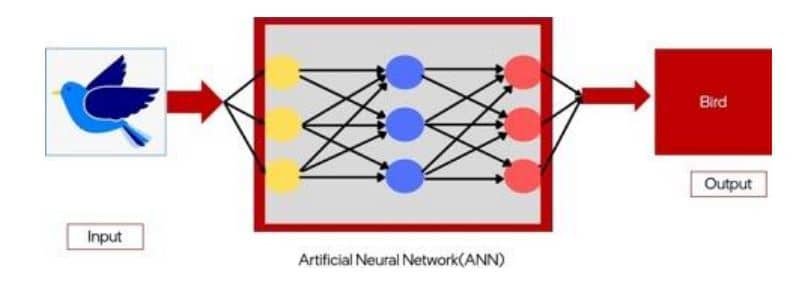
Here is an example which shows pixels of a bird image given as input to the DL Model and the model is able to analyze and correctly predict that it is a bird using a deep learning algorithm (ANN).
Examples of Deep Learning (DL)
- Object Identification – Object classification in deep learning tackles the task of identifying and labeling objects within an image. It essentially uses powerful algorithms to figure out what’s in a picture and categorize those things.
- Digit Recognition – Digit recognition in deep learning tackles the challenge of training computers to identify handwritten digits (0-9) within images.
Common terminologies used with data
What is Data?
Data is information in any form For e.g. A table with information about fruits is data, Each row will contain information about different fruits. Each fruit is described by certain features
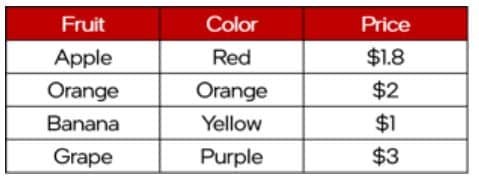
What do you mean by Features?
Columns of the tables are called features, In the fruit dataset example, features may be name, color, size, etc., Some features are special, they are called labels
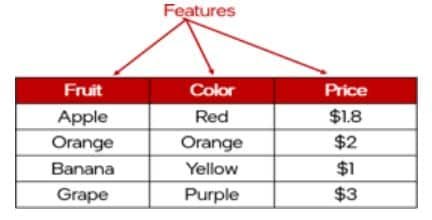
What are Labels?
Data Labeling is the process of attaching meaning to data. For e.g. if we are trying to predict what fruit it is
based on the color of the fruit, then color is the feature, and fruit name is the label. Data can be of two types – Labeled and Unlabeled
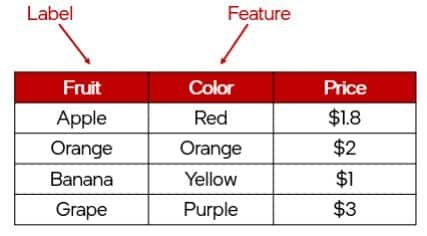
What are Labeled Data?
Data to which some tag/label is attached is known as labeled data. For example, name, type, number, etc. Unlabeled data is a raw form of data that has no tag attached.
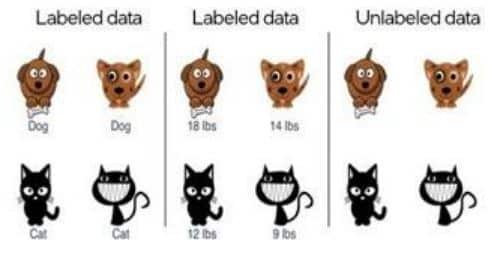
What do you mean by a training data set?
The training data set is a collection of examples given to the model to analyze and learn. Just like how a teacher teaches a topic to the class through a lot of examples and illustrations. Similarly, a set of labeled data is used to train the AI model.
What do you mean by a testing data set?
The testing data set is used to test the accuracy of the model. Just like how a teacher takes a class test related to a topic to evaluate the understanding level of students. Test is performed without labeled data and then verify results with labels.
Modelling
AI Modelling refers to developing algorithms, also called models which can be trained to get intelligent outputs. An AI model is a program that uses algorithms to analyze data and make decisions without human intervention. AI models are trained on data sets to recognize patterns and perform tasks.
There are two different approaches in AI models
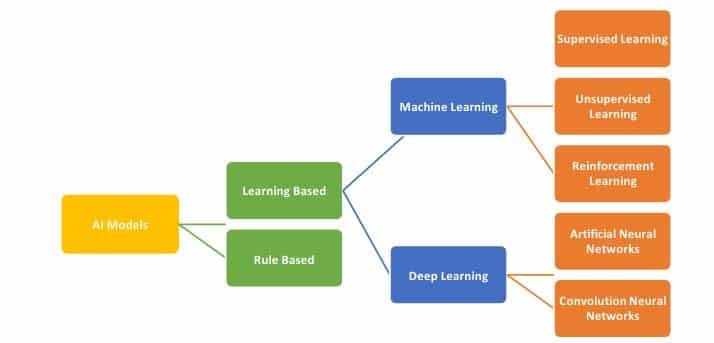
- Rule Based Approach
- Learning Based Approach
Rule Based – Rule Based AI modelling where the rules are defined by the developer. The machine follows the rules or instructions mentioned by the developer and performs its task accordingly. For example, Rule-based Chatbots are commonly used on websites to answer frequently asked questions (FAQs) or provide basic customer support.

A drawback of the rule-based approach
- In a rule-based approach, the learning is static.
- Once trained, the machine will not make any changes in the training dataset.
- If you try testing the machine on a dataset which is different from the rules and data you fed it at the training stage, the machine will fail and will not learn from its mistake.
- Once the model is trained, the model cannot improvise itself on the basis of feedback.
- In a rule-based model, it does what it has been taught once.
Learning Based – Refers to the AI modelling where the machine learns by itself. Under the Learning Based approach, the AI model gets trained on the data fed to it and then is able to design a model which is adaptive to the change in data. Random data is provided to the computer in this method, and the system is left to figure out patterns and trends from it.

The learning-based approach can further be divided into three parts:
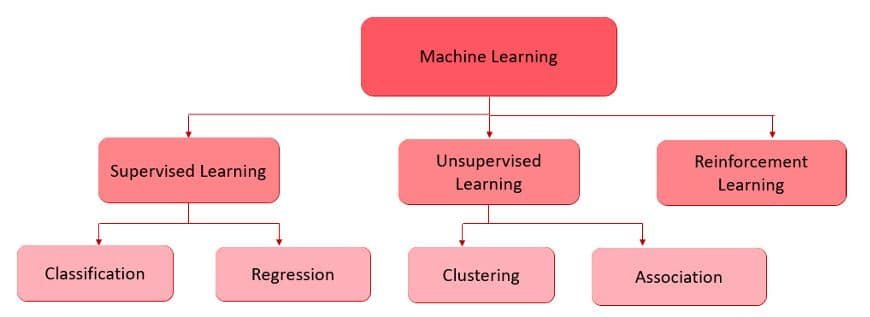
- Supervised Learning
- Unsupervised Learning
- Reinforcement Learning
1. Supervised Learning
Supervised learning is a machine learning technique that uses labeled data to train algorithms to predict outcomes. In a supervised learning model, the dataset which is fed to the machine is labelled. In other words, we can say that the dataset is known to the person who is training the machine only then he/she is able to label the data.
Supervised Learning – Example
Let’s consider the example of currency coins. Problem Statement: Build a model to predict the coin based on its weight. Assume that we have different currency coins (dataset) having different weights. 1 Euro weighs 5 grams, 1 Dirham weighs 7 grams, 1 Dollar weighs 3 grams, 1 Rupee weighs 4 grams and so on.
- Feature – Weights,
- Label – Currency
So, if a model is trained in tagging the features i.e., the weights of the coin with the targets i.e., currency, the trained model can be further be used to identify a coin based on its weight (since it has already learnt).
There are two types of Supervised Learning models:
a. Classification
Where the data is classified according to the labels. For example, in the grading system, students are classified on the basis of the grades they obtain with respect to their marks in the examination. This model works on discrete dataset which means the data need not be continuous.
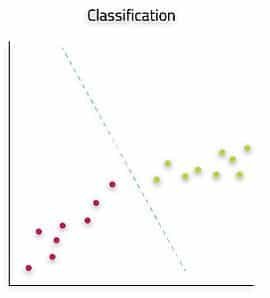
Examples of the Classification Model
Classifying emails as spam or not: The model is shown tons of emails, both real ones (like from friends or colleagues) and spam. The model learns what makes an email look like spam. Once trained, the model sees a new email. It analyzes the clues in the email and decides: is this spam or not? It assigns a category – “spam” or “not spam” – just like sorting your mail.
b. Regression
Such models work on continuous data. For example, if you wish to predict your next salary, then you would put in the data of your previous salary, any increments, etc., and would train the model. Here, the data which has been fed to the machine is continuous.
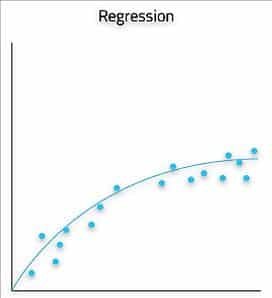
Examples of the Regression Model
Predicting temperature: Temperature is a continuous variable, meaning it can take on any value within a range. Regression models are well-suited for predicting continuous outputs.
Used Car Price Prediction: This model predicts the selling price of the car with the help of a few parameters like
fuel type, years of service, the number of previous owners, kilometers driven, transmission type (manual/automatic) This type of model will be of type regression since it will predict an approximate price
(continuous value) of the car based on the training dataset.
2. Unsupervised Learning
An unsupervised learning model works on unlabeled dataset. This means that the data which is fed to the machine is random and there is a possibility that the person who is training the model does not have any information regarding it. It helps the user in understanding what the data is about and what are the major features identified by the machine in it.
Unsupervised Learning – Example
Assume that we have a customer database with records of their products bought over a period. Now you being the marketing manager decides to send a grocery offer message to those customers who buys grocery regularly. Model could discover patterns on its own and could come up with two different group a) Grocery Shopper and Non-grocery Shopper.
Unsupervised learning models can be further divided into two categories:
a. Clustering
Refers to the unsupervised learning algorithm which can cluster the unknown data according to the patterns or trends identified out of it. The patterns observed might be the ones which are known to the developer, or it might even come up with some unique patterns out of it.
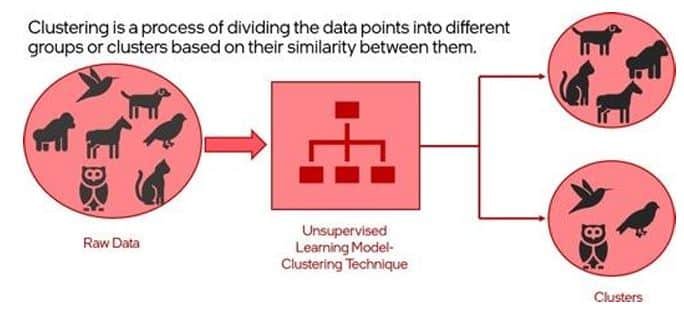
What is the difference between Clustering and Classification?
- Classification uses predefined classes in which objects are assigned.
- Clustering finds similarities between objects and places them in the same cluster and it differentiates them from objects in other clusters.
b. Association
Association is another type of unsupervised learning method that uses different rules to find relationships between variables in a given data set. This is a data mining technique used for better understanding of customer purchasing patterns based on relationships between various products.
Example,
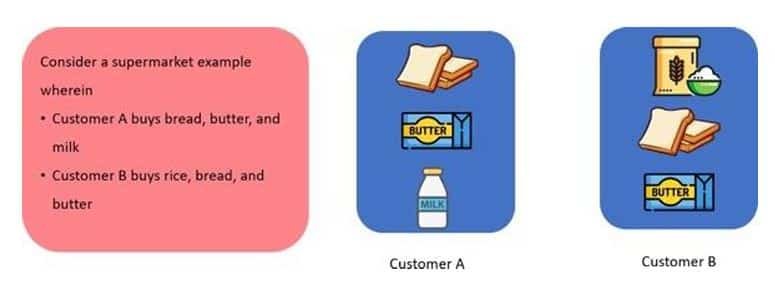
Based on the purchase pattern of customers A and B, can you predict any Customer X who buys bread will most probably buy?
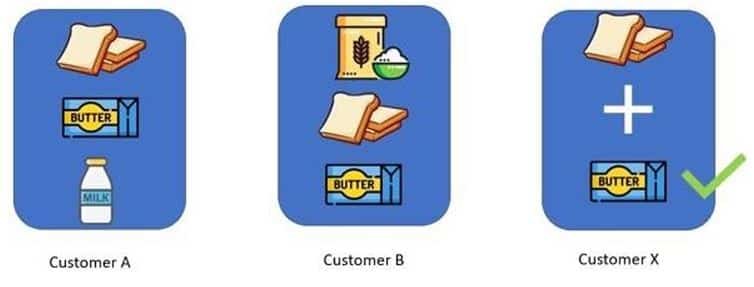
Based on the purchase pattern of other customers, we can predict that there is high probability that any customer x who buys bread will most probably buy butter. Therefore, such meaningful associations can be useful to recommend items to customers. This is called Association Rule.
3. Reinforcement Learning
This learning approach enables the computer to make a series of decisions that maximize a reward metric for the task without human intervention and without being explicitly programmed to achieve the task. It’s based on a trial-and-error learning process to achieve the goals. Examples of reinforcement learning are question and answering, machine translation, and text summarization.
Reinforcement Learning – Example
Reinforcement learning is a type of learning in which a machine learns to perform a task through a repeated trial-and-error method. Let’s say you provide an image of an apple to the machine and ask the machine to predict it. The machine first predicts it as ‘cherry’ and you give negative feedback that it’s incorrect. Now, the machine learns that it’s not a cherry.
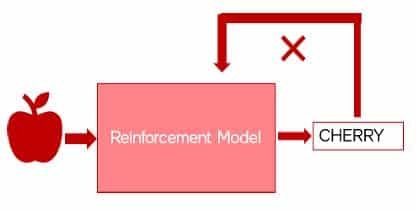
Then again, you ask the machine to predict the fruit by giving an image of an apple as input; Now, it knows it is not a cherry. It predicts it as an apple, and you give positive feedback that it’s correct. So, now the machine learns that this is an apple.
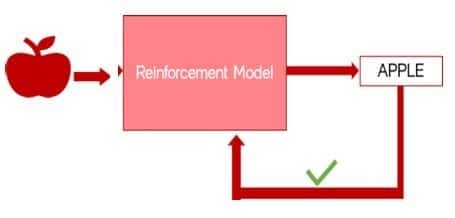
Difference between supervised and unsupervised Learning?
| Supervised Learning | Unsupervised Learning |
|---|---|
| Deals with labelled data | Deals with unlabeled data |
| Useful in real-world problems like predicting the prices of an item something based on past trends. | Useful in finding unknown patterns within data like making sence of a large number of observations from an experimental device. |
| Computing power required is simpler as clean labelled data is used as input. | The computing power required is more complex as unsorted and messy data is used as input |
Summary of ML Models
- Supervised learning models are used when we want to determine relationships through training.
- Unsupervised learning models are used when we want to discover new patterns from data.
- Reinforcement learning models are used when we want to implement machine learning through a reward mechanism.
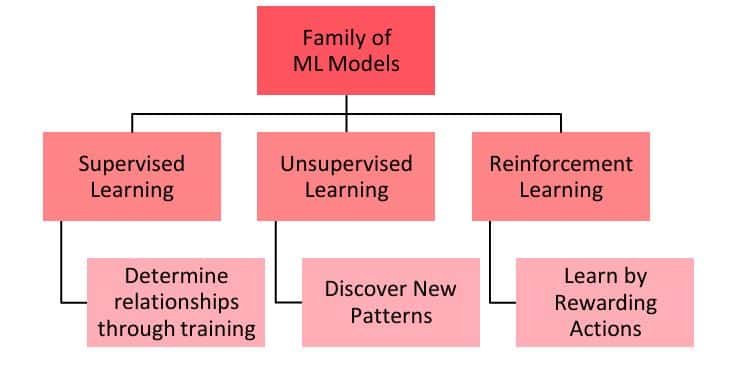
Sub-Categories of Deep Learning
Deep learning is a subset of machine learning that uses artificial neural networks to learn from data. In deep learning, the machine is trained with huge amounts of data, which helps it in training itself around the data. Such machines are intelligent enough to develop algorithms for themselves. Deep learning is the most advanced form of artificial intelligence.
Subcategories of Deep Learning:
- Artificial Neural networks (ANN)
- Convolutional Neural Network (CNN)
1. Artificial Neural networks (ANN)
What is Neural Network?
Neural networks are modelled on the human brain and nervous system. They are able to automatically extract features without input from the programmer. Every neural network node is essentially a machine learning algorithm. It is useful when solving problems for which the data set is very large.
How neural networks work:
An artificial neural network is a type of machine learning algorithm derived from biological neural network principles that can work similarly to the human brain using neuron interconnection. These neurons are known as nodes. An artificial neural network has an input layer, an output layer, and hidden layers. The input layer is responsible for receiving the data from the real world, and all the input data passes through one or multiple hidden layers and transforms the result using the output layer.
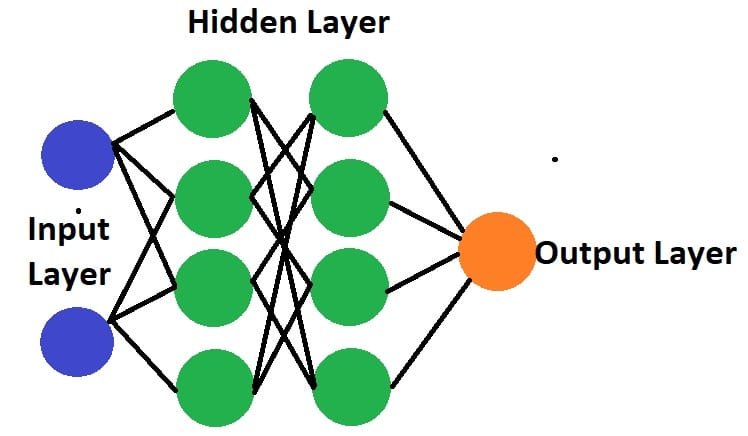
The structure of an entire artificial neural network consists of
- Input layer – takes input data and transfers it to the hidden layer of neurons using synapses.
- Hidden layer – takes data from the input layer to categorize the data and send it to more hidden layers and finally send it to the output layer.
- Output layer – takes the data from the hidden layer and generates the result.
How do Artificial Neural Networks learn?
Artificial neural networks are trained using a training set. For example, suppose you want to teach an ANN to recognize a dog; using the input layer, thousands of different dog images will be shown to the neural network. Once the neural network is trained, then ANN will help to identify whether the neural network has identified the dog correctly or not. When output is generated, then ANN will verify the dog image against the human-provided description. If the ANN finds it incorrect, then backpropagation is used to adjust the image during the training. This process continues until the ANN can correctly recognize a dog in an image.
2. Convolutional Neural Network (CNN)
A Convolutional Neural Network (CNN) is a Deep Learning algorithm which can take in an input image, assign importance (learnable weights and biases) to various aspects/objects in the image and be able to differentiate one from the other.
The process of deploying a CNN is as follows:
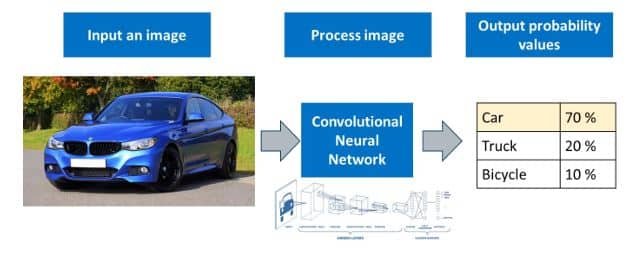
In the above diagram, we give an input image, which is then processed through a CNN and then gives prediction on the basis of the label given in the particular dataset.
The different layers of a Convolutional Neural Network (CNN) is as follows:
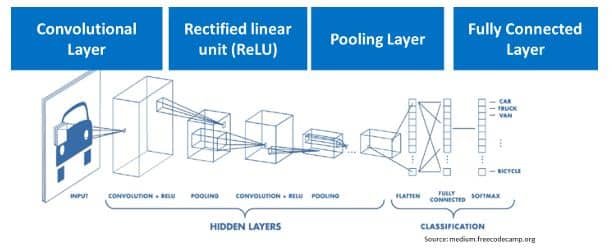
A convolutional neural network consists of the following layers:
- Convolution Layer
- Rectified linear Unit (ReLU)
- Pooling Layer
- Fully Connected Layer
Convolution Layer – A convolutional layer is the first layer and the main building block of CNN that extracts features from images. In the convolution layer, there are several kernels that are used to produce several features. The output of this layer is called the feature map. A feature map is also called the activation map. We can use these terms interchangeably.
There’s several uses we derive from the feature map:
- We reduce the image size so that it can be processed more efficiently.
- We only focus on the features of the image that can help us in processing the image further.
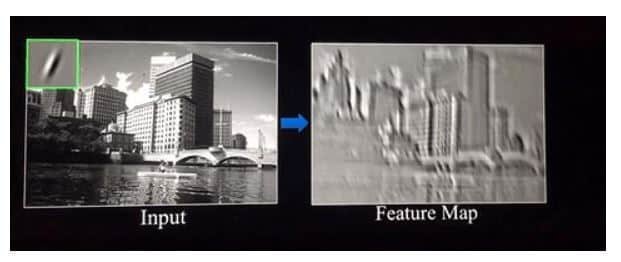
Rectified Linear Unit Function – After we get the feature map, it is then passed onto the ReLU layer. This layer simply gets rid of all the negative numbers in the feature map and lets the positive number stay as it is.
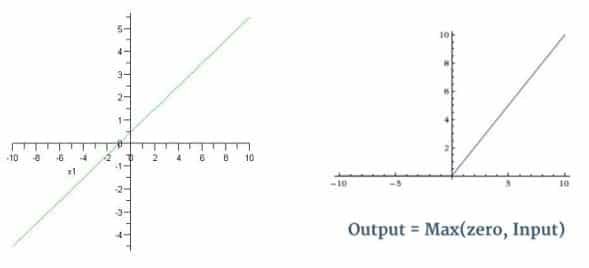
If we see the two graphs side by side, the one on the left is a linear graph. This graph when passed through the ReLU layer, gives the one on the right. The ReLU graph starts with a horizontal straight line and then increases linearly as it reaches a positive number.
Why do we pass the feature map to the ReLU layer?
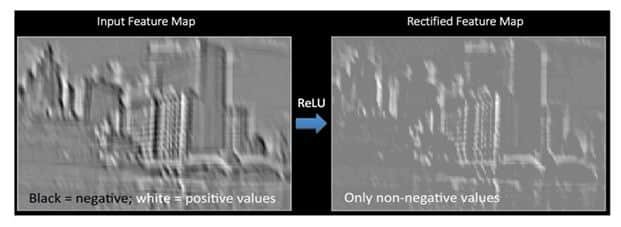
As shown in the above convolved image, there is a smooth grey gradient change from black to white. After applying the ReLu function, we can see a more abrupt change in color which makes the edges more obvious which acts as a better feature for the further layers in a CNN as it enhances the activation layer.
Pooling Layer – Similar to the Convolutional Layer, the Pooling layer is responsible for reducing the spatial size of the Convolved Feature while still retaining the important features.
There are two types of pooling which can be performed on an image.
- Max Pooling: Max Pooling returns the maximum value from the portion of the image covered by the Kernel.
- Average Pooling: Max Pooling returns the maximum value from the portion of the image covered by the Kernel.
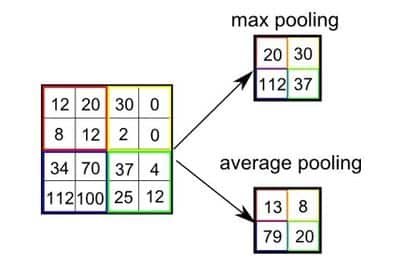
The pooling layer is an important layer in the CNN as it performs a series of tasks which are as follows:
- Makes the image smaller and more manageable
- Makes the image more resistant to small transformations, distortions and translations in the input image.
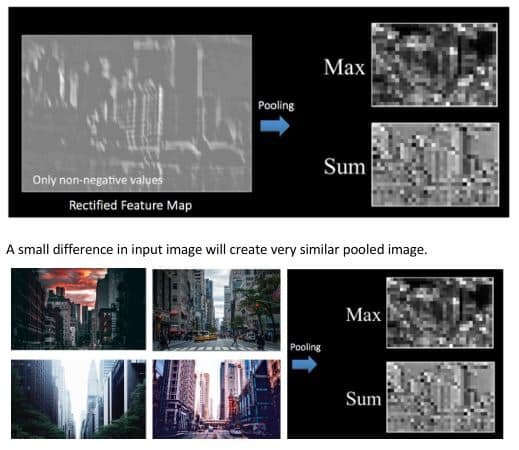
Fully Connected Layer – The final layer in the CNN is the Fully Connected Layer (FCP). The objective of a fully connected layer is to take the results of the convolution/pooling process and use them to classify the image into a label (in a simple classification example). For example, if the image is of a cat, features representing things like whiskers or fur should have high probabilities for the label “cat”.

Human Neural Network – The Game
TensorFlow Playground is a browser-based software that allows the users to experiment with neural networks and machine learning algorithms. TensorFlow can simulate small neural networks in real time in your browser and see the result instantly.
Disclaimer: We have taken an effort to provide you with the accurate handout of “Advance Concepts of Modeling in AI class 10 notes“. If you feel that there is any error or mistake, please contact me at anuraganand2017@gmail.com. The above CBSE study material present on our websites is for education purpose, not our copyrights. All the above content and Screenshot are taken from Artificial Intelligence Class 10 CBSE Textbook and Support Material which is present in CBSEACADEMIC website, This Textbook and Support Material are legally copyright by Central Board of Secondary Education. We are only providing a medium and helping the students to improve the performances in the examination.
Images shown above are the property of individual organizations and are used here for reference purposes only.
For more information, refer to the official CBSE textbooks available at cbseacademic.nic.in

Great for exams
This THE best website ever ……… I am so grateful I found this …….. But only problem cannot print / download it.